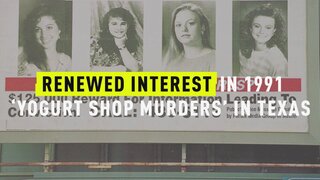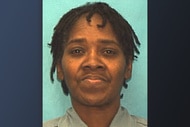Create a free profile to get unlimited access to exclusive videos, breaking news, sweepstakes, and more!
"Pure, Unadulterated Evil": Why are Austin’s Yogurt Shop Murders Still Unsolved After 30 Years?
Eliza Thomas, 17, Jennifer Harbison, 17, Sarah Harbison, 15, and Amy Ayers, 13, were shot and killed execution-style at an Austin yogurt shop in 1991. Their killer or killers have never been caught.
More than three decades ago, the nude bodies of four teen girls were found amongst the ashes of an Austin yogurt shop following a robbery gone horrifically wrong.
Seventeen-year-old store workers Eliza Thomas and Jennifer Harbison, as well as 15-year-old Sarah Harbison and 13-year-old Amy Ayers were found bound, gagged, and raped at the restaurant. The case haunts Austin to this day.
As the 33rd anniversary of one of Texas’ most notorious cold case killings approaches, justice still hasn’t been served — and cold case detectives have yet to pinpoint their killer or killers.
Keep reading to learn more about the investigation...
RELATED: Texas Police Seeking Answers in Death of Woman Found Burned Alive
What were the Yogurt Shop Murders?
On Dec. 6, 1991, authorities responded to reports of a fire at the Austin yogurt shop, I Can’t Believe It’s Yogurt!
Firefighters, who quickly extinguished the blaze, made a ghoulish discovery in and around the storage room area of the yogurt shop: the charred, bound, and naked bodies of four teenage girls who had been shot in the head.
“They came in with hoses blazing — that’s their job,” Dick Ellis, a former ABC affiliate KVUE journalist who reported on the story at the time, told the outlet. “They believed it was just a fire, but after the flames were put out, they discovered the girls’ bodies.”
A .22 revolver and a .380 semi-automatic pistol were believed to have been used in the killings, according to The Austin American-Statesman.
The series of murders rocked Austin. A $100,000 reward was subsequently offered by a private group of entrepreneurs.
“It was pure, unadulterated evil,” Ellis added.
Who were the Yogurt Shop Murder victims?
Eliza Thomas, Jennifer Harbison, as well as her younger sister, Sarah Harbison and Amy Ayers, were killed in the attack.
Eliza and Jennifer were I Can’t Believe It’s Yogurt! employees. Jennifer's little sister Sarah and Sarah's friend, Amy, who were also at the shop, had planned to get a ride home with Jennifer after the store closed at 11 pm.
Investigators theorize that the four teens were forced into the storage room where the gunman or gunmen forced them to undress, bound them in their own undergarments and sexually assaulted some of them. Thomas, Ayers, and Jennifer and Sarah Harbinson were all shot and killed execution-style with a single gunshot wound to the back of their heads.
After committing the grisly killings, the teens’ killer or killers ignited a fire using paper plates, cups, and cardboard from the yogurt shop, which had been soaked in lighter fluid.
The inferno, as well as the water from responding firefighters’ hoses in the aftermath of the blaze, destroyed countless clues that could have aided detectives. The fire had reportedly burnt so hot that it melted the upper rungs of a thick aluminum ladder in the rear of the business, KVUE reported.
RELATED: Everything to Know About Polly Klaas, the Girl Kidnapped from a Slumber Party and Killed
Who committed the Yogurt Shop Murders?
It’s a mystery.
Over the years, law enforcement have apprehended and even sourced false confessions from multiple people who initially admitted involvement in the four teens’ killings, according to PEOPLE. All in all, detectives have eyed more than 1,200 possible suspects — including a gang of Mexican motorcycle outlaws — in the decades-old cold case.
Detectives first centered investigative efforts around four teenage boys: Robert Springsteen, Michael Scott, Maurice Pierce, and Forrest Welborn. Pierce, who coincidentally had been found by police in possession of a .22 caliber handgun — the same caliber as the yogurt shop killings murder weapon — was taken into custody and was let go after admitting the four murders, but was freed after law enforcement didn’t find his confession credible.
In 1999, eight years after the quadruple homicide, however, authorities announced they’d arrested the four teens, now men, in connection to the yogurt shop slayings. After being interviewed by police, Scott and Springsteen, ultimately confessed to the killings of Thomas, Ayers and Jennifer and Sarah Harbinson.
Both men were found guilty. Scott was sentenced to death, while Springsteen was dealt a life sentence. The convictions, however, didn’t stick, and were struck down by the Texas Court of Appeals. The court had ruled Scott and Springsteen weren’t given the opportunity to conduct a cross-examination of one another, per PEOPLE. The pair were freed on bond in June 2009. Charges were later dropped.
Two customers who were at I Can't Believe It's Yogurt! around the time of the killings recalled seeing two individuals at the shop before it closed at 11 p.m. Those customers were described by other patrons as "out of place," per CBS News.
"They never have been identified," Austin police detective John Jones told CBS News. "And we did everything. … We even hypnotized some folks."
Despite the damage to the crime scene, a partial DNA profile was also found at the scene of the quadruple homicide, per Austin television station KEYE-TV. The sample, however, only had 16 genetic markers, which the outlet reported, wasn’t enough to incriminate, but could potentially eliminate a possible suspect.
Nonetheless, detectives remain hopeful the scant genetic material still could one day help build a case against the teenage girls’ killer or killers. Still, after more than three decades, the case still remains unsolved.
In 2017, Austin detectives also submitted the DNA sample into a database, which later matched to an unidentified individual, CBS News reported. According to the report, the FBI had provided the matcher’s sample, but the individual's identity wasn’t included with the specimen. Federal agents, citing privacy, ultimately couldn't reveal the person's identity.

































